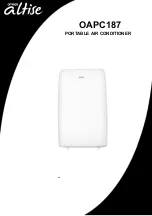
64
Short-cycle protection management (SCP):
- Call for power:
If the only available stage is in SCP mode, the machine remains in its current state and SCP is indicated by the flashing LED on the console.
Before a stage is turned on, the runtime of each stage is always checked so that the stage that has run the least is started first.
13.4 Management of the reversing valves
The reversing valves are fitted on reversible units only.
They are managed by the following convention:
- In cooling mode: the reversing valves are supplied.
- In heating mode: the reversing valve are not supplied.
The supply to the reversing valves is cut off 30 minutes after the last stage on the corresponding circuit is turned off. This time delay becomes
30 seconds in test mode.
13.5 Management of configurable output P111:
The output between terminals 9-10 on terminal block J3 on the motherboard is configurable so that the customer can define its function.
Max. power:
The NC contact informs the customer that the unit is running at full power (all compressors and all electric stages).
Boiler:
The NC contact allows the customer to activate an auxiliary heater. This type of operating mode is described in section 21
“Management of the back-up boiler”.
Cooling/Heating:
The NC contact informs the customer of the heating operation of the unit. The NO contact informs the customer of the
cooling operation of the unit.
Backup on all faults (on air-to-water machines only):
The NC contact informs the customer that the machine is either not operating at full capacity (a compressor is off) or has been shut off
following the detection of a fault. The machine will remain off until the fault is acknowledged with the Reset button.
Display:
Machine fault output on
- General fault LED on console lit steady
To see which type fault caused the machine to be shut off, go to the fault memory.
List of faults and impairments that shut off the machine if P111 is set to 'backup on all faults':
- Pump fault
- Intermediate and final water flow fault
- Limiter on water outlet
- Intermediate and final water frost fault
- Limiter on refrigerant
- Intermediate and final frost fault on refrigerant
- Exchanger frosting fault
- Limiter on high pressure
- Intermediate and final high pressure control fault
- Manual high pressure fault
- Motor fault
- Limiter on discharge
- Intermediate and final discharge fault
- Intermediate and final low pressure fault
- Water inlet sensor fault
- Exchanger 1 or 2 water sensor fault
- Refrigerant sensor fault
- Discharge sensor fault
- Manifold water outlet sensor fault if control on outlet
- Sensor fault
- Excessively low outdoor temperature fault
- Electronic expansion valve fault
- Fan fault if P3 and P180 = 1
- Maximum superheat fault
- Minimum superheat fault
- Limiter on max. air during cooling
- Phase controller fault
- Suction sensor fault if P43 = Yes
- Excessively high outdoor temperature fault
14 SELF-ADJUSTING FUNCTIONS
These functions allow the machine to adjust itself to certain occasionally extreme operating conditions and thus avoid stops caused by faults.
14.1 Self-adjusting function: water frost limit
Operation:
- Before shutting down after a fault occurs, the unit reduces its power by turning off a stage (if there are two on the circuit), or by reducing the
compressor to half speed. In the case of I
NVERTER
units, they shut off if they are already running at half speed.
- The threshold is detected by the water outlet sensor at P52 + 0.8 K.
- The unit returns to normal operation at P52 + 2 K for 5 minutes and then the HP gradually rises to its set threshold (P181).
- This function operates on each circuit.
Display:
14.2 Self-adjusting function: refrigerant frost limit
Operation:
Before shutting down after a fault occurs, the unit reduces its power by turning off a stage (if there are two on the circuit), or by reducing the
compressor to half speed
. In the case of I
NVERTER
units, they shut off if they are already running at half speed. It raises the high pressure
level by decreasing the speed of the fans (units with air-cooled condensers only).
The threshold is detected by the sensor placed on the freon pipe at the evaporator inlet at P52 - P53 + 2 K for 10 seconds. The unit returns to
normal operation at P52 - P53 + 3.5 K and then the HP gradually rises to its set threshold (P181).
Display:
M A C H I N E O F F
F A U L T S O R L I M I T E R
C I R C . x W A T E R F R O S T L I M
P O W E R R E D U C .
C I R C . x R E F R I G F R O S T L I M
P O W E R R E D U C .
Содержание Magister 2 Series
Страница 2: ......
















































